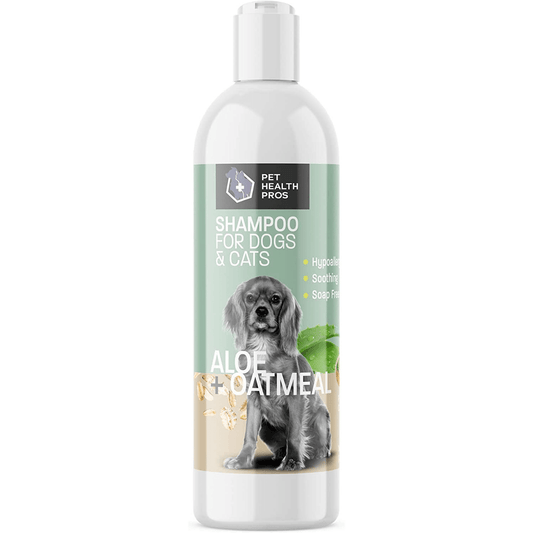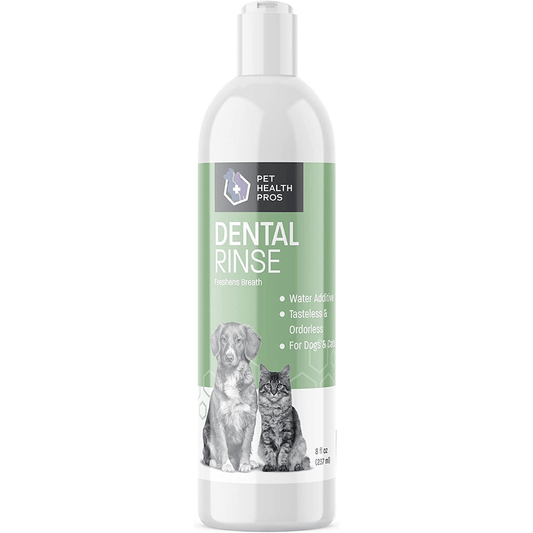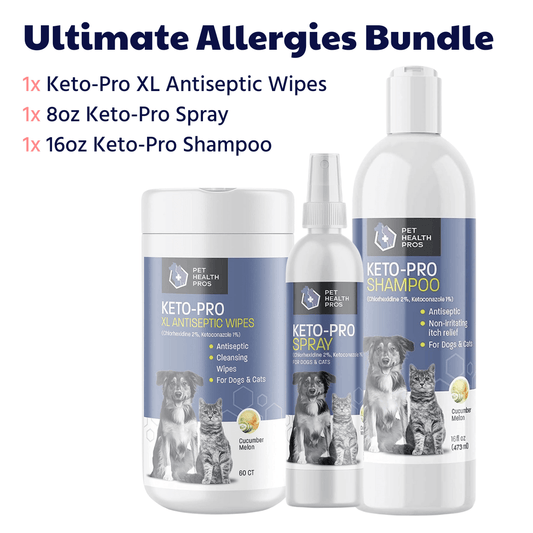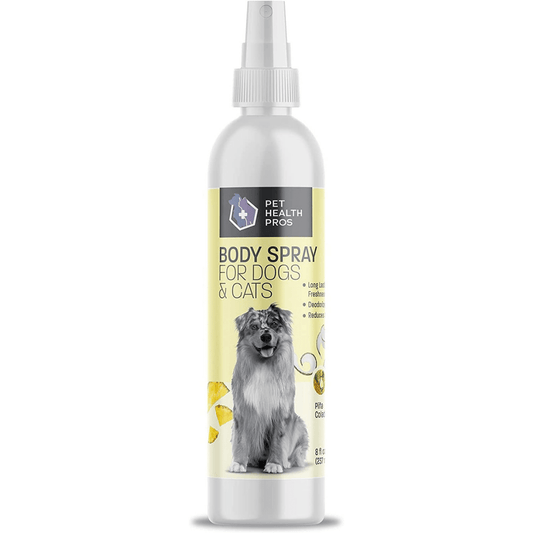Handling a pet's injury can be a stressful experience for any owner. It's crucial to know the right steps to take to ensure the safety and well-being of your furry companion. This guide, brought to you by Pet Health Pros, a U.S.-based company with over fifty years of experience in veterinary medicine and animal health management, will walk you through the process of assessing the situation, providing first aid, transporting your injured pet, and ensuring a comfortable recovery. With our expertise-driven approach and commitment to pet health, we aim to support you in managing your pet's injury effectively.
Key Takeaways
- Remain calm and carefully assess your pet's injury, prioritizing safety while identifying the type and severity of the injury to determine if immediate veterinary care is needed.
- Equip yourself with a basic first aid kit, and learn how to manage bleeding, wounds, sprains, and fractures to provide initial care before professional help is available.
- Understand the importance of safe transportation, preparing your pet for the journey and choosing the appropriate mode of transport to minimize discomfort and prevent further injury.
- Post-injury care is vital for a full recovery; create a comfortable space for your pet, monitor for complications, and ensure they receive proper nutrition and hydration.
- Prevent future injuries by scheduling regular health check-ups, providing safe play and exercise, and implementing home safety measures to protect your pet's well-being.
Assessing the Situation
Stay Calm and Approach Safely
When your pet is injured, your response can significantly affect their stress levels and recovery. Stay calm and speak to your pet in a soothing voice to help them remain as relaxed as possible. Approach your pet slowly and gently to avoid startling them, which could exacerbate the injury or cause them to react defensively.
Before you touch your pet, observe their body language for signs of pain or fear. If your pet is showing aggression due to pain, it may be necessary to muzzle them for both your safety and theirs. Always ensure that you're not putting yourself at risk of injury.
Remember, a calm and measured approach is crucial for the safety and well-being of both you and your pet during this stressful time.
To prevent future incidents, consider pet-proofing your home. This includes securing hazardous items and ensuring safe kitchen practices. Here are some tips for creating a safer environment:
- Secure loose wires and small objects that can be chewed or swallowed.
- Use child-proof latches to keep cabinets closed.
- Ensure trash cans are inaccessible or have secure lids.
- Remove toxic plants and substances from your pet's reach.
Identifying the Type of Injury
Once you've ensured your own safety and approached your pet calmly, the next critical step is to identify the type of injury they have sustained. Assess the injury carefully, looking for signs such as bleeding, swelling, or an inability to move a limb, which could indicate a fracture or sprain. It's important to note the location and severity of the injury, as this will inform your first aid response and the urgency of seeking veterinary care.
Symptoms can vary widely depending on the injury, so here's a basic guide to help you determine the nature of the injury:
- Bleeding: Apply pressure with a clean cloth to stop the bleeding.
- Lacerations or punctures: Clean the wound with water and mild soap.
- Swelling or limping: May indicate a sprain or fracture; immobilize the limb if possible.
- Unconsciousness or disorientation: Keep your pet warm and quiet while you seek immediate veterinary help.
Remember, your primary goal is to stabilize your pet and prevent further harm while you prepare for transportation to a professional. Do not attempt to treat serious injuries at home.
If you're unsure about the severity of the injury or how to manage it, it's always best to consult with a veterinarian. For non-life-threatening injuries, a well-stocked first aid kit is invaluable. Ensure you have one on hand that includes items such as gauze, antiseptic wipes, and adhesive tape. For more detailed guidance on administering first aid and recommended products, consider resources like the guide on administering first aid to dogs, which covers essential steps and top pet health products.
When to Seek Immediate Veterinary Care
Recognizing when your pet needs immediate veterinary care is crucial. If your pet is experiencing severe bleeding, difficulty breathing, or signs of a broken bone, it's time to seek emergency care. Other red flags include loss of consciousness, severe pain, or suspected poisoning. In such cases, prompt action can be the difference between life and death.
Symptoms that warrant immediate veterinary attention include, but are not limited to:
- Profuse bleeding
- Choking or difficulty breathing
- Inability to stand or walk
- Severe vomiting or diarrhea
- Signs of extreme pain (whining, shaking, or reluctance to be touched)
- Suspected broken bones or severe lameness
- Eye injuries
- Seizures or loss of consciousness
- Suspected ingestion of toxic substances
It's essential to have the contact information of your nearest veterinary emergency clinic readily available. In the event of an emergency, time is of the essence, and knowing where to go can save precious minutes.
When in doubt, it's always better to err on the side of caution and contact your veterinarian or an emergency pet clinic. They can provide guidance on whether your pet's symptoms require immediate care or if they can wait for a scheduled appointment.
Providing First Aid
Basic First Aid Kit Essentials
Having a well-stocked first aid kit is crucial for any pet owner. Ensure your pet's safety and well-being by being prepared for any minor injuries or emergencies that may occur. A basic pet first aid kit should include the following items:
- Sterile gauze pads and rolls for wrapping wounds
- Adhesive tape for securing gauze
- Cotton balls or swabs for cleaning around injuries
- Disposable gloves to maintain cleanliness
- Scissors with blunt ends for cutting tape or fur
- Tweezers for removing splinters or ticks
- Antiseptic wipes or solution to disinfect
- A digital thermometer to check your pet's temperature
- Saline solution for flushing out wounds
- A pet-safe antiseptic ointment
- A syringe or dropper for administering oral treatments
It's also important to include a list of emergency phone numbers, such as your veterinarian, a local emergency vet clinic, and the Animal Poison Control Center. Keep this list in a clear and accessible place within the kit.
Remember to check your first aid kit regularly and replace any expired or used items. Being proactive in your approach to pet care can prevent more serious health issues and provide peace of mind. For more comprehensive care, consider products from trusted brands like Pet Health Pros, which offer expertly crafted solutions to support your pet's health.
Managing Bleeding and Wounds
When your pet sustains a wound or is bleeding, prompt and proper action is crucial to prevent infection and ensure a swift recovery. Apply direct pressure to the wound with a clean cloth to control bleeding. If the bleeding is severe and does not stop, seek veterinary assistance immediately.
For minor wounds, clean the area gently with antiseptic solution and apply a sterile bandage. Avoid using cotton as it can stick to the wound and cause irritation. Here's a simple list of steps to follow:
- Restrain your pet calmly to prevent further injury.
- Apply pressure to the bleeding site with a clean cloth or gauze.
- Clean the wound with antiseptic solution once bleeding is controlled.
- Cover the wound with a sterile bandage or dressing.
- Monitor the wound for signs of infection, such as redness, swelling, or discharge.
Remember, never apply a tourniquet unless directed by a veterinarian, as it can cause more harm than good.
Always have a first aid kit ready and know the location of the nearest emergency veterinary clinic. By being prepared and knowledgeable, you can provide the best care for your pet in a stressful situation.
Dealing with Sprains and Fractures
When your pet suffers a sprain or fracture, it's crucial to minimize movement to prevent further injury. A sprain may involve a stretched or torn ligament, while a fracture refers to a break in the bone. Both require careful handling and often veterinary intervention.
- First, if you suspect a fracture, do not attempt to set the bone yourself.
- Second, immobilize the affected area with a makeshift splint or sling. Use rolled up magazines or towels for splints, and a scarf or bandana for a sling.
- Third, apply a cold compress to reduce swelling, but never place ice directly on the skin.
- Fourth, ensure your pet is comfortable and unable to move excessively during transport to the vet.
Remember, pain management is essential. If your pet is in pain, they may react unpredictably, so approach with caution and use a muzzle if necessary to protect both you and your pet.
After stabilizing your pet, consult with a veterinarian as soon as possible. They can provide a proper diagnosis and treatment plan. For ongoing care, consider consulting resources like the Pet Health Pros website, which offers educational content and training tips to promote well-behaved pets and prevent future injuries.
Transporting Your Injured Pet
Preparing for Safe Transportation
When your pet is injured, ensuring their safety during transportation to a veterinary clinic or hospital is crucial. Before you move your pet, assess their condition carefully to avoid causing further harm. Use a pet carrier or a makeshift stretcher for animals that cannot walk or are in severe pain.
Comfort is key during transport. Line the carrier with a soft blanket to reduce stress and provide cushioning for the injury. If a carrier isn't available, a sturdy box or a flat, firm surface can serve as an alternative. Always support the head and neck of your pet if they have sustained any injuries in these areas.
It's essential to remember that traveling with loose dogs in the car is dangerous. Use a pet restraint for safety, provide water and ventilation, and take breaks for comfort and safety.
Here are some tips to prepare for your pet's transportation:
- Ensure the pet is securely placed within the carrier or restraint.
- Cover open wounds with clean bandages to prevent infection.
- Keep a calm demeanor to help soothe your pet.
- Avoid feeding your pet right before the trip to prevent nausea.
- Plan the route to the veterinary clinic beforehand to minimize travel time.
Handling Your Pet with Care
When your pet is injured, handling them with care is crucial to prevent further harm. Always support your pet's injured areas to avoid exacerbating the injury. Use gentle motions and speak in a soothing tone to keep them calm.
Immobilization is key when dealing with injuries, especially fractures or severe sprains. A makeshift splint or sling may be necessary to stabilize the affected limb during transport. However, if you're unsure how to properly immobilize the injury, it's best to leave it to the professionals to avoid causing more damage.
Ensure that your movements are slow and deliberate to minimize stress on your pet. Avoid any sudden jolts or movements that could cause pain or worsen the injury.
Here are some tips for handling your pet with care:
- Approach your pet slowly and calmly to avoid startling them.
- If possible, use a pet carrier or a sturdy box to transport smaller animals.
- For larger pets, a blanket can serve as a stretcher to evenly distribute their weight.
- Always keep the injured area elevated if it's a limb injury.
- Avoid squeezing or applying pressure to the injured site.
Remember, your goal is to provide comfort and prevent additional injury until you can get your pet the professional care they need.
Choosing the Right Mode of Transport
Once you've stabilized your pet's injury and are ready to move them to professional care, choosing the right mode of transport is crucial. For smaller pets, a carrier or a sturdy box with ventilation may suffice. Larger animals might require a stretcher or a firm, flat surface to keep them immobilized during the journey.
Transportation options vary based on the urgency of the situation, the size of your pet, and the distance to the veterinary clinic. Here's a quick guide to help you decide:
- Personal vehicle: Ideal for non-emergency situations and when you have the means to comfortably fit your pet.
- Pet ambulance: A service equipped with medical supplies for emergency situations.
- Taxi or ride-sharing service: Ensure the service is pet-friendly and inform them of your situation beforehand.
Remember, the safety and comfort of your pet during transport can significantly affect their recovery process.
Always inform the veterinary clinic of your estimated time of arrival and the nature of your pet's injury. This allows them to prepare for immediate treatment upon your arrival. For added support, consider services like Pet Genius which offer emergency support and personalized care plans for your pet.
Post-Injury Care and Observation
Creating a Comfortable Recovery Space
After your pet has sustained an injury, creating a comfortable recovery space is crucial for their healing process. Ensure the area is quiet, warm, and free from drafts to promote rest and reduce stress. The space should be easily accessible and free of obstacles that could cause further harm.
Comfort is key when it comes to recovery. Consider the following elements for your pet's recovery area:
- Bedding: Use thick, soft bedding to support your pet's body and prevent pressure sores.
- Temperature: Maintain a consistent, warm temperature, especially for pets with short fur or those prone to feeling cold.
- Accessibility: Place food, water, and a litter box or pee pads within easy reach if your pet has limited mobility.
Remember, the goal is to minimize your pet's movement and provide a sanctuary where they can recuperate without additional stress or discomfort.
Regularly check and clean the space to ensure it remains a safe and sanitary environment for your pet's recovery. By taking these steps, you can help your pet heal more comfortably and possibly speed up their recovery time.
Monitoring for Signs of Complications
After your pet has sustained an injury and received initial treatment, it's crucial to monitor them closely for any signs of complications. Prompt detection and response can be the difference between a quick recovery and a prolonged illness.
Be vigilant for symptoms such as persistent pain, swelling, or redness, which could indicate infection or inflammation. Other concerning signs include lethargy, loss of appetite, or unusual behavior that deviates from your pet's normal patterns. Here's a list of common complications to watch for:
- Increased or continuous bleeding
- Signs of infection (pus, foul odor, fever)
- Difficulty breathing
- Excessive licking or biting at the injury site
- Behavioral changes (aggression, depression)
It's essential to maintain a log of your pet's symptoms and behaviors post-injury. This record will be invaluable for your veterinarian to assess the healing process and make any necessary adjustments to the treatment plan.
If you observe any of these symptoms, or if something just doesn't seem right, contact your veterinarian immediately. Early intervention is key in preventing minor issues from escalating into serious health problems. Remember, your pet's well-being is dependent on your attentiveness and proactive care.
Ensuring Proper Nutrition and Hydration
After an injury, your pet's body needs the right nutrients to heal and recover. Ensuring proper nutrition and hydration is crucial for their well-being. A balanced diet rich in proteins, vitamins, and minerals supports tissue repair and boosts the immune system. Hydration is equally important, as water helps transport nutrients to cells and flushes out toxins.
Hydration should be monitored closely, especially if your pet is less active or has a decreased appetite. Fresh water should always be available, and you may need to encourage your pet to drink by offering wet food or using water fountains.
It's essential to follow your veterinarian's dietary recommendations during recovery. They may suggest a special diet or supplements to address your pet's specific needs.
Here are some general guidelines to consider for your pet's nutrition and hydration:
- Maintain a regular feeding schedule.
- Offer a variety of foods to stimulate appetite.
- Monitor water intake and ensure clean water is accessible.
- Avoid giving human food that can be harmful or disrupt healing.
Remember, each pet is unique, and their needs may vary depending on the injury and overall health. Consult with your vet for personalized advice.
Preventing Future Injuries
Regular Health Check-Ups and Vaccinations
Ensuring your pet's long-term health involves more than just reacting to injuries or illnesses. Regular health checks and vaccinations are crucial components of preventative care. These check-ups allow veterinarians to detect and address health issues before they become serious. During a routine visit, a vet will typically assess your pet's weight, dental hygiene, mental well-being, grooming needs, and diet to ensure they are maintaining optimal health.
Vaccinations play a vital role in protecting your pet from various diseases. They are an essential part of your pet's health regimen and should be kept up to date according to the recommended schedule. Here's a basic guideline for canine vaccinations:
- Rabies: Every 1-3 years
- Distemper, Parvovirus, and Adenovirus: Every 3 years
- Bordetella: Annually
- Leptospirosis: Annually, if at risk
Remember, a balanced diet and regular grooming are also part of keeping your pet healthy. These practices help prevent issues such as obesity, dental disease, and skin problems.
By maintaining a schedule of regular health checks and staying on top of vaccinations, you are taking proactive steps to ensure your pet's well-being. This not only helps to prevent future injuries but also contributes to a happier and more fulfilling life for your furry companion.
Safe Play and Exercise Tips
Ensuring your pet remains injury-free during play and exercise is crucial for their overall well-being. Always supervise your pet's activities to prevent accidents and injuries. Use toys that are appropriate for your pet's size and strength, and avoid any items that can be easily broken into small, swallowable pieces.
Exercise is essential for your pet's health, but it's important to tailor it to their age, breed, and health status. Here's a simple guide to help you:
- Young and energetic pets may require more frequent and vigorous playtime.
- Older pets or those with health issues may benefit from shorter, gentler exercise sessions.
- Always provide plenty of fresh water, especially after exercise.
Remember, the goal is to keep your pet active and engaged while minimizing the risk of injury. Regularly check their toys and equipment for any signs of wear and tear, and replace them when necessary.
By following these tips, you can create a safe environment that encourages healthy play and exercise for your pet.
Home and Environment Safety Measures
Creating a safe home environment is crucial for preventing injuries and ensuring the well-being of your pet. Start by pet-proofing your home, removing any potential hazards such as toxic plants, small objects that can be swallowed, and securing loose wires or cords.
Regularly inspect your home for any new risks, and consider the following safety measures:
- Install safety gates to restrict access to dangerous areas.
- Use secure screens on windows to prevent falls.
- Keep all chemicals and medications out of reach.
- Ensure trash cans have lids to avoid ingestion of harmful substances.
Remember, a safe environment is a controlled environment. By taking proactive steps, you can minimize the risk of accidents and create a peaceful space for your pet to thrive.
Finally, integrate safety into your daily routine. Check your pet's play area for hazards before letting them loose, and always supervise interactions with new pets or children. By being vigilant and maintaining a safe environment, you contribute significantly to your pet's happiness and health.
Ensuring your well-being is our top priority, and preventing future injuries is a crucial part of maintaining a healthy lifestyle. Our comprehensive guides and resources are designed to educate and empower you to take control of your health. Don't let a past injury dictate your future activities. Visit our website now for expert advice and tips on staying injury-free. Take the first step towards a safer and more active life today!
Conclusion
In conclusion, handling your pet's injury with care and precision is crucial for their recovery and well-being. By following the step-by-step guide provided, you can ensure that you're prepared to act swiftly and effectively in the event of an injury. Remember to stay calm, assess the situation, and provide the necessary first aid before seeking professional veterinary assistance. It's also important to have the right supplies on hand, and Pet Health Pros offers a range of expertly crafted pet health products that can aid in your pet's healing process. With over fifty years of experience in veterinary medicine and a commitment to quality and customer satisfaction, Pet Health Pros is a trustworthy partner in maintaining your pet's health. Keep your pet's safety in mind, and don't hesitate to reach out to professionals when needed. Your pet relies on you, and with the right knowledge and tools, you can ensure they receive the best care possible.
Frequently Asked Questions
How can I tell if my pet's injury is serious and needs immediate veterinary care?
Signs that your pet requires immediate veterinary care include excessive bleeding, apparent broken bones, difficulty breathing, sudden collapse, or signs of pain such as whining, shaking, or reluctance to move. If in doubt, it's always best to consult with a veterinarian.
What should be included in a basic first aid kit for pets?
A basic first aid kit for pets should include gauze pads, adhesive tape, cotton balls, tweezers, scissors, a digital thermometer, antiseptic wipes, saline solution, and a pet-safe antiseptic ointment. Always check with your vet for a complete list tailored to your pet's needs.
How do I safely transport my injured pet to the vet?
To safely transport an injured pet, use a pet carrier or make a makeshift stretcher if the pet is too large. Support the pet's neck and back if you suspect a spinal injury. Keep the pet warm and calm, and avoid any unnecessary movement that could worsen the injury.
What is the best way to create a comfortable recovery space for my pet?
A comfortable recovery space for your pet should be quiet, warm, and free from disturbances. Provide a soft bed or blanket, keep the area clean, and ensure easy access to food and water. It's important to limit your pet's movement to prevent further injury.
How can I prevent future injuries to my pet?
To prevent future injuries, ensure your pet gets regular health check-ups, provide a balanced diet and appropriate exercise, pet-proof your home to remove hazards, and supervise your pet during playtime. Training your pet to follow commands can also reduce the risk of injuries.
What are the benefits of choosing Pet Health Pros for my pet's health supplies?
Pet Health Pros offers superior pet health supplies developed in collaboration with veterinarians, made with locally sourced, top-grade ingredients. With a 100% satisfaction guarantee and over fifty years of experience in veterinary medicine, they provide expertly crafted solutions to enhance the lives of pets and reassure their owners.









